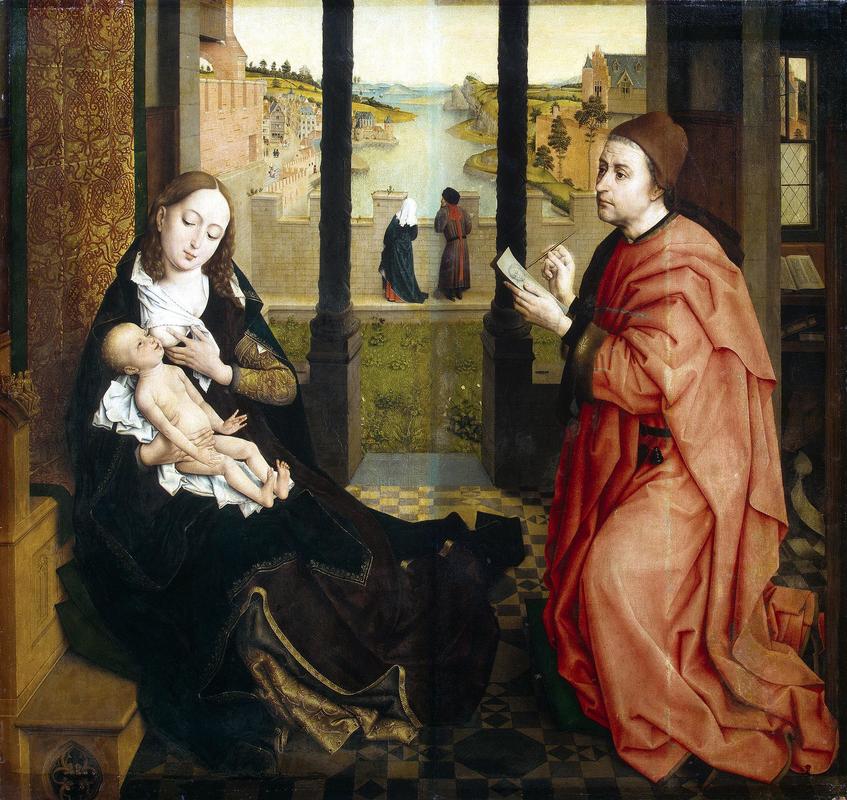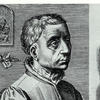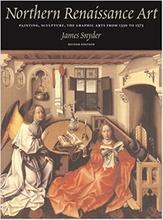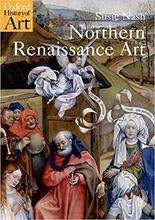More about Saint Luke Drawing the Virgin
- All
- Info
- Shop

Contributor
Rogier van der Weyden became Brussels’s official painter by the 1430s.
This painting is allegedly the first one he made in that office. The setting is based on a traditional belief that Saint Luke had painted the Virgin Mary and the infant Jesus from life, despite the fact that Luke was alive long after she and the baby Messiah were long gone. It didn’t stop the Middle Ages and the Renaissance: many painters’ guilds were named after Luke, and hundreds of icons were alleged to be painted by his hand.
There’s more to this painting than meets the eye. For starters, it may not actually be Saint Luke painting Mary, but in fact, Weyden himself. “Luke,” compared to the two figures to the left, is painted more detailed and realistically. A certain Spanish court painter did something similar much later, if I remember correctly. Scattered across the painting are various symbols with religious significance: the throne behind the Virgin, the human figurines on the throne’s arm closest to the the viewer, and a bull behind the painter. The first signifies Mary’s future status, the second represent her destiny to liberate man from the original sin of Adam and Eve, and the third is Saint Luke’s personal symbol. Additionally, X-ray images reveal Weyden went thorugh several revisions right under the finished product, including changes of position in hands and in facial expression.
Saint Luke was one of the Four Evangelists, the men credited with writing the Four Gospels that make up the bulk of the New Testament. Of the four books, Luke’s rendition of Jesus’s life and ministry is written with the most focus on his divine and otherworldly nature. Thematically, his version of the Gospel centers primarily on forgiveness and mercy. Only in Luke does the parable of the Prodigal Son and the washing of the woman’s feet show up.
Sources
- Ellis, E. Earle. 2018. “St. Luke.” Encyclopædia Britannica. Encyclopædia Britannica, inc. May 17, 2018. https://www.britannica.com/biography/Saint-Luke.
- Ishikawa, Chiyo. "Rogier Van Der Weyden's "Saint Luke Drawing the Virgin" Reexamined." Journal of the Museum of Fine Arts, Boston 2 (1990): 49-64. http://www.jstor.org/stable/20519725.
- “Saint Luke Paints the Virgin and Child: Genealogy of an Image.” n.d. Italian Renaissance Learning Resources. Accessed May 11, 2019. http://www.italianrenaissanceresources.com/units/unit-1/essays/saint-lu…
- “St Luke Drawing the Virgin.” n.d. The State Hermitage Museum. The State Hermitage Museum. Accessed May 11, 2019. https://www.hermitagemuseum.org/wps/portal/hermitage/digital-collection…. Paintings/38861/?lng=en.
Featured Content
Here is what Wikipedia says about Saint Luke Drawing the Virgin
Saint Luke Drawing the Virgin is a large oil and tempera on oak panel painting, usually dated between 1435 and 1440, attributed to the Early Netherlandish painter Rogier van der Weyden. Housed in the Museum of Fine Arts, Boston, it shows Luke the Evangelist, patron saint of artists, sketching the Virgin Mary as she nurses the Child Jesus. The figures are positioned in a bourgeois interior which leads out towards a courtyard, river, town and landscape. The enclosed garden, illusionistic carvings of Adam and Eve on the arms of Mary's throne, and attributes of St Luke are amongst the painting's many iconographic symbols.
Van der Weyden was strongly influenced by Jan van Eyck, and the painting is very similar to the earlier Madonna of Chancellor Rolin, usually dated to around 1434, with significant differences. The figure's positioning and colourisation are reversed, and Luke takes centre stage; his face is accepted as van der Weyden's self-portrait. Three near contemporary versions are in the Hermitage Museum, Saint Petersburg, the Alte Pinakothek, Munich, and the Groeningemuseum, Bruges. The Boston panel is widely considered the original from underdrawings that are both heavily reworked and absent in other versions. It is in relatively poor condition, having suffered considerable damage, which remains despite extensive restoration and cleaning.
The painting's historical significance rests both on the skill behind the design and its merging of earthly and divine realms. By positioning himself in the same space as the Madonna, and showing a painter in the act of portrayal, Van der Weyden brings to the fore the role of artistic creativity in 15th-century society. The panel became widely influential with near copies by the Master of the Legend of Saint Ursula and Hugo van der Goes.
Check out the full Wikipedia article about Saint Luke Drawing the Virgin















It looks great, because it include the Bible story.